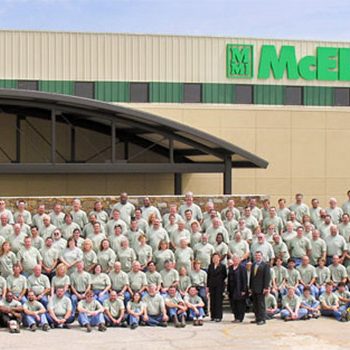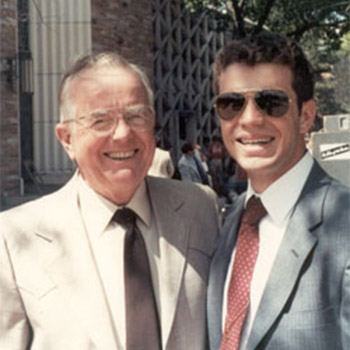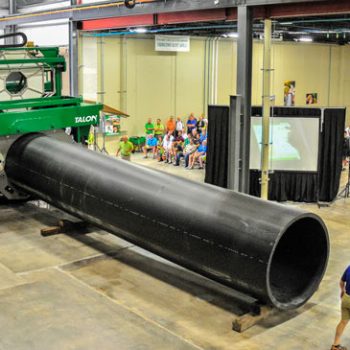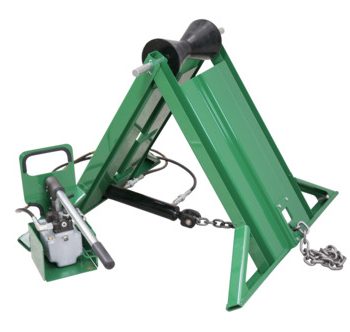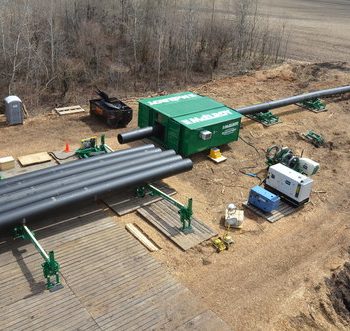Hard work is said to result in living the American dream. This ethos is one of the reasons McElroy has been a viable company for 60 years, but it’s just one part of the equation that made McElroy the world’s leading manufacturer of butt fusion machines for thermoplastic pipe.
There were other essential qualities that Art McElroy possessed when he started the company in his garage in Tulsa, Oklahoma, in 1954: an enduring passion for building better products and, with the support of his loving wife, Panny, the courage to dream.
Like true entrepreneurs, Art and Panny had their humble beginnings and expanded as their means allowed. The believed that their business was simply an extension of their family and they invited their employees, industry partners and customers into their home and life. Today, that garage has transformed into more than 400,000 square feet of facilities spanning the globe.
McElroy’s business initially focused on fintube machines and building products for the aerospace and aviation industries. It is estimated that as much as 80 percent of all the finned tubes in the world have been made by McElroy machines.
We have engineers now across the country looking at thermoplastic pipe as a primary solution
Development of fusion machines started in 1969 with the first machine known as the 4″ Hand Pump. Phillips Petroleum Co., which was developing high-density polyethylene (HDPE) pipe at the time, had asked Art to make fusion equipment for them, and as with most challenges, Art stepped up to the plate and met the challenge. He realized early on that he needed to do more than just build equipment, he needed to help Phillips and others create a market.
Dedicated to working closely with customers to create the best designs to serve their jobsite needs, McElroy has the unique distinction of having the most extensive line of fusion machines in the industry.
McElroy adopted innovations such as the Centerline Guidance System which applies equal distribution of force to create a quality fusion. This patented technology is used on every McElroy machine today and has helped solidify its hard-won reputation for reliable and quality products.
When Art McElroy died in 1988, his son, Chip McElroy, took over the company as president. Along with his sisters, Donna Dutton as executive vice president of finance and Peggy Tanner as executive vice president of international market development, they have led McElroy through its greatest period of economic growth.
They not only held on to their father’s dream; they took it to the next level. In the past five years despite the turmoil of the national economic downturn, the company has more than doubled its revenues and staffing levels.
Setting ambitious goals is an integral part of the culture at McElroy. There is always a new summit to reach. The growing acceptance of thermoplastic pipe and its growing applications around the world gives them no reason to believe they can’t get there.
Countless piping systems have aged out and need to be replaced across the country and thermoplastic pipe is being viewed as the solution. Its long lifespan, durability, non-corrosive qualities and leak-free system joined through butt fusion is looking more attractive all the time to communities that are plagued with infrastructure failures.
McElroy is taking off in the thermoplastic world as much now as they were in ’70s when it was a much newer concept.
“The whole idea of thermoplastic piping really is just coming into some sense of maturity. It’s no longer that boutique niche product that people went to when nothing else would work,” said Chip McElroy. “We have engineers now across the country looking at thermoplastic pipe as a primary solution. That’s a huge change, and we think it’s going to have a dramatic effect on our business in the years ahead.”
McElroy is also branching into indoor piping systems with the making of an entire line of tools and machines that fuse polypropylene pipe — in an effort to make mechanical contractors jobs not only safer but faster, easier and cleaner.
“Polypropylene pipe offers something we’ve never had with HDPE and that is you can bring it inside the building. Architects and engineers like bringing it inside the building and they like it because it’s light, it’s clean, installation doesn’t involve open flames, it doesn’t have volatility in pricing and it’s a sealed system that doesn’t tuberculate,” McElroy said.
The equipment to fuse polypropylene pipe is designed to be lightweight and flexible enough to work in tight indoor spaces, but it still has the rugged reliability expected from a McElroy machine.
In 1997, McElroy introduced the TracStar® 500, the first self-propelled, tracked fusion machine which eventually led to an entire line of tracked machines. They continue to build on their history of innovation with new projects like the Talon™ 2000 — the largest machine it has ever built. The revolutionary design was drawn from the growing popularity of 2000mm pipe and has the ability to lift pipe from the ground, position it to be fused and move from joint to joint down the pipeline.
One of McElroy’s many productivity products is the QuickCamp™ System, a lighted, insulated and climate-controlled enclosure that allows operators to fuse pipe day or night under all weather conditions. McElroy has focused on making all of its machines the most productive in the industry as well as creating accessories, from pipe stands to pipe loading systems, to enhance that productivity.
McElroy also manufactures quality assurance accessories like the DataLogger® series to help the industry show accountability of their work before pipelines are buried and the new online DataLogger Vault™ which allows storage and analysis of fusion joint reports in the cloud.
New products also created a demand for more manufacturing space. McElroy opened a second plant in 2006 followed by a third plant in 2013 specifically to assemble the large-diameter machines.
In addition, McElroy is expanding its reach in the thermoplastic market beyond high-density polyethylene (HDPE) and Fusible PVC to include nylon-based pipes which carry higher pressure ratings.
The company continues to also expand its fintube and pipe fusion products in new markets like India, Australia, Russia and Brazil. McElroy has an extensive and growing distributor network in North America and a growing number of distributors internationally.
People remember Art McElroy walking around with a yellow legal pad and black felt-tip pen. He was always ready to jot down a new idea. He truly wanted to help people solve problems and give them the tools they need to create the best infrastructure the world has to offer. That same calling holds true today at McElroy.
“Whether it’s underground, in the building or around the world, we stand for making a difference in the world through better infrastructure. We’re passionate about that mission,” McElroy said.
